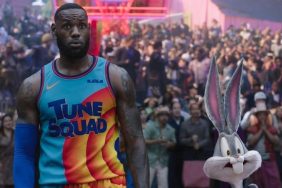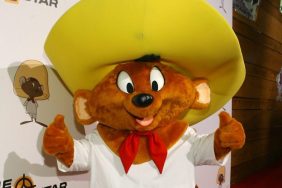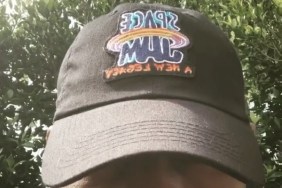That’s not all folks! Warner Bros. has announced that there will be a third live-action Looney Tunes film, this time written by comedian Jenny Slate, who appeared in “Bored to Death,” “Saturday Night Live” and Alvin and the Chipmunks: Chipwrecked. As with the last two Looney Tunes movies, this new film will feature the classic cartoon characters interacting with real-life actors, doubtless to capitalize on the recent success of similar films like The Smurfs and, well, Alvin and the Chipmunks. Is it a good idea? Probably not, but it’s happening anyway.
The Looney Tunes – a universe of cartoon characters that includes Bugs Bunny, Daffy Duck and Porky Pig – have had many feature-length movies before this, although most of them were basically wrap-around devices to present older material. Daffy Duck’s Quackbusters features Daffy Duck as a paranormal investigator, and featured such classic monster-themed shorts as “Water, Water Every Hare” and “Claws for Alarm.” Daffy Duck’s Island found Daffy as the proprietor of an honest to God wishing well, and the rest of the Looney Tunes cast lined up so their wishes could segue into old shorts like “Captain Hareblower” and “Stupor Duck.”
This trend ended with 1996’s Space Jam, a financially successful but pandering motion picture that starred NBA superstar Michael Jordan, who was called out of one of his many retirements to play basketball with the Looney Tunes, who wagered their freedom from alien slave drivers on a big game. Few seem to remember Space Jam with any particular fondness, as the Looney Tunes cast was often played out of character, Bugs Bunny was forced into an unconvincing love story with a hip new (read: bland) character named Lola Bunny, and the overall impression that the movie was little more than a corporate cash grab. Seven years later, Gremlins director Joe Dante tried his hand at the live-action/cartoon format with Looney Tunes: Back in Action, a superior film in many regards – funnier and faithful to the legacy of the characters – but suffering from a forgettable storyline. The film tanked at the box office, perhaps due to the ill will held over from Space Jam and a release date immediately following Elf and The Matrix Revolutions.
So considering that there has never been both a financially and critically successful live-action/Looney Tunes hybrid, we here at CraveOnline are presenting How to Make a Good (and Bad) Looney Tunes Movie. Here’s our handy list of “Dos” and “Don’ts” to help Warner Bros. learn from their mistakes and finally take that left turn at Albuquerque.
DO…
1. …Make the Looney Tunes Part of the “Real” World

To children and life-long fans everywhere, the Looney Tunes are real. Many of them even work at Warner Bros. studios, as established in 1940’s “You Ought To Be In Pictures,” an early, successful attempt to juxtapose the Looney Tunes with real life figures, like animation producer Leon Schlesinger. This is one of the elements of the characters that Looney Tunes: Back in Action got right. The focus of that film was a producer (Jenna Elfman), who attempted to make the cartoon stars relevant by, fittingly enough, committing many of the same storytelling sins as Space Jam. A little too insider for casual audiences, but the tone was struck. The new Looney Tunes movie can’t establish the cartoon characters as existing in an alternate reality. Bugs Bunny is as real as Arnold Schwarzenegger to audiences everywhere. Treat him that way.
2. …Keep Them In Character

Daffy Duck’s egomania is not a character he plays. Yosemite Sam is not calm when he’s off-camera. The Looney Tunes aren’t just defined by their character models, they’re defined by their carefully crafted comedic personas. Again, this is something Looney Tunes: Back in Action understood. The plot kicked off when Daffy Duck was fired by a producer who didn’t understand that Bugs Bunny isn’t as funny without him. This applies across the board: the Roadrunner isn’t funny without Wile E. Coyote obsessive attempts to catch him, the Tazmanian Devil isn’t funny without Bugs Bunny responding to his emotional outbursts with a calm demeanor. The characterizations need to remain consistent, regardless of the events the new movie places them in, otherwise they’re just not the Looney Tunes.
3. ….Keep It Simple

The Looney Tunes don’t need a big conspiracy to unravel, or a retcon that calls into question the very nature of their existence. They need a simple problem to solve, perhaps together but more effectively on an individual basis. Think It’s a Mad, Mad, Mad, Mad World or, for the younger development executives out there, Rat Race. You have a cast of superstars. Put them in a position to compete with each other, and solve the same problem in their own distinctive ways, and then sit back and enjoy the ride because the Looney Tunes are so well defined from a comedic perspective that they basically write their own material. A cross-country race will work. A unified effort to save Warner Bros. studios would have been fine if The Muppets hadn’t done it first. Just keep it simple, and don’t shoehorn the Looney Tunes into a situation where they don’t belong like, say, an arbitrary basketball game.
4. …Make It Timeless

The old Looney Tunes shorts still work today, and are as funny as ever, because for the most part they avoided pop culture commentary. Sure, there were World War II cartoons and caricatures of famous celebrities, but for the most part these aren’t the Looney Tunes that stood the test of time. Case in point: Space Jam, a 16-year-old film that already seems like a gaudy relic of the 1990s. Celebrity cameos are allowed, but allow the comedy to flow from the personalities of the already funny characters and you’ll wind up with a comedy with legs, not a flash in the pan cash-in on marketable characters.
5. …Bring Back the Animaniacs

There’s an entire generation of Looney Tunes fans who didn’t just grow up with Bugs and Daffy, but who also grew up with their extended cartoon family. The Animaniacs in particular are perhaps equally respected by modern audiences as classic Warner Bros. cartoon creations, and despite our desire for timelessness, are welcome in a new Looney Tunes feature. The Tiny Toons perhaps deserve their own feature, since their cast was large enough to potentially distract from the classic characters, but if they do show up in some capacity their presence will be welcome. And Freakazoid would, at the very least, be an excellent cameo appearance to lampoon superhero trends that popped up since his show’s untimely cancellation. These are Looney Tunes, beloved and hilarious, and they belong in the same universe as the original cast.
DON’T…
1. …Use 3D Animation

The recent Warner Bros. short film “Daffy’s Rhapsody,” which played in front of Journey 2 The Mysterious Island, was proof positive that the classic Looney Tunes character designs to not look right in three-dimensional CG-animation. Even if they did, they’re not the Looney Tunes that audiences fell in love with over the last 82 years. There is absolutely no good reason to use CG creations over the cast’s 2D counterparts, and if that decision is eventually made, lifelong fans are likely to reject the new movie outright, sight unseen. If it ain’t broke, don’t fix it.
2. Make the Main Character Human

The Looney Tunes are the stars here, not “Celebrity X.” If Bugs and Daffy have to interact with the real world, because that’s the genre these days, then fair enough, but don’t make the film dependent on the live-action cast. The audience wants to see the Looney Tunes, fittingly enough, back in action. Our interest in Emma Stone’s boyfriend troubles, or the efforts of a temporarily popular child actor to bring their divorced parents back together. They want to see the Looney Tunes solving their own problems, interacting with each other and perhaps even competing towards a common goal. The presence of real-life actors is the gimmick, not the presence of Looney Tunes in the so-called “real world.”
3. …Parody Contemporary Films

Nobody wants to see a Looney Tunes parody of Twilight, or Spider-Man, or Transformers, or Avatar. This kind of humor will reek of pandering, and tell the audience that the Looney Tunes aren’t being respected, they’re being treated as buffoons through which other, and by implication more “culturally significant,” material is lampooned. The world has changed since the heyday of Merrie Melodies, and you’re allowed to mine those cultural shifts for comedy, but the more specific you make them references the less timeless, and the less funny, the movie will be.
4. …Try to Sell Us Something

Product placement is a fact of life in moviemaking, but for once, we beg you to keep it to a minimum. The Looney Tunes, we say for the umpteenth time, deserve respect as cultural icons. They do not exist to sell iPhones or whatever Michael Jordan is plugging this week. Warner Bros., you are selling the Looney Tunes themselves to a generation that hasn’t had a quality introduction to the characters, at least with fresh material. Focus on that, not product placement.
5. …Bring Back Lola Bunny

Nobody liked her, nobody cares. She is not an official part of the Looney Tunes cannon, at least to the serious fans of the character. Bringing her back would unduly legitimize Space Jam as worthy of being considered a proper “Looney Tune,” and imply that the filmmakers have no idea why the film did not remain popular after the initially successful theatrical run. Bringing back Lola Bunny would be roughly equivalent to Zack Snyder making Ned Beatty’s Superman henchmen the main villain in Man of Steel. If she’s present, audiences will immediately suspect that you don’t know what you’re doing.
Well folks, that’s what we’ve got for Warner Bros. to chew on. What suggestions do you have to make the new Looney Tunes movie (which is getting made whether we like it or not) a good one?








